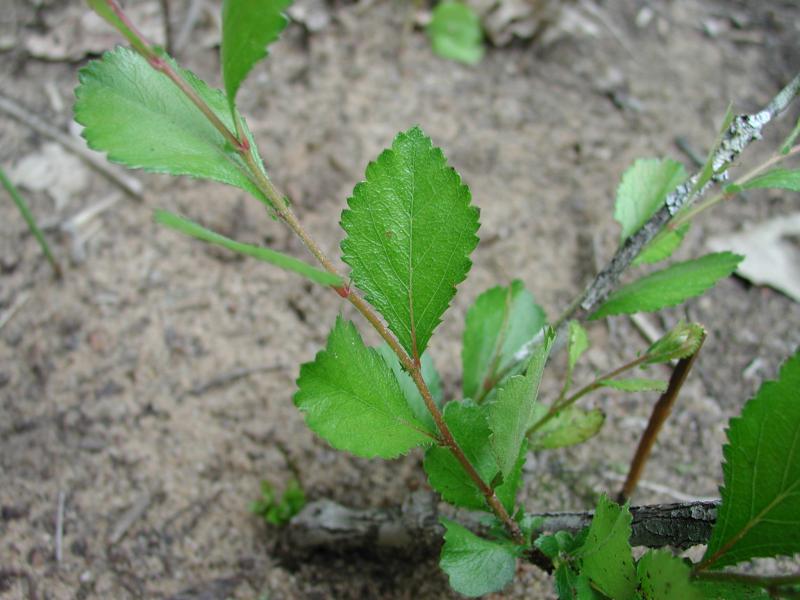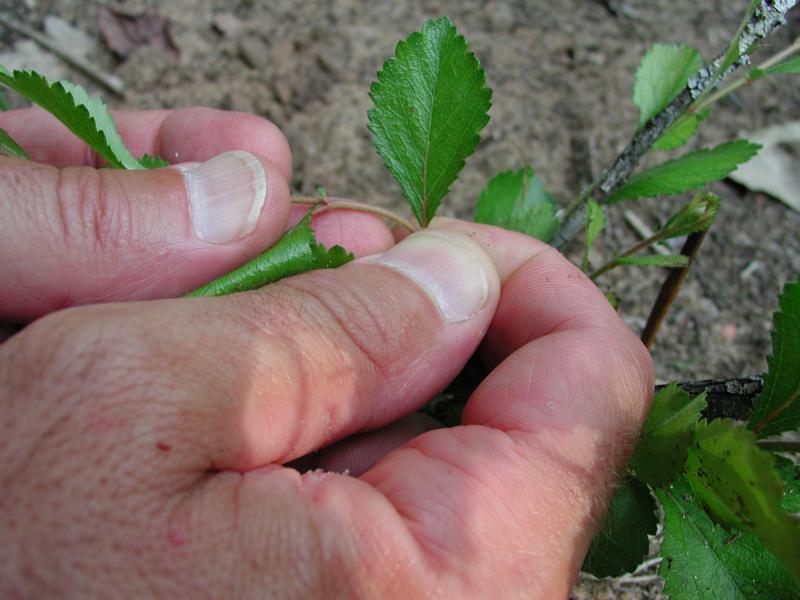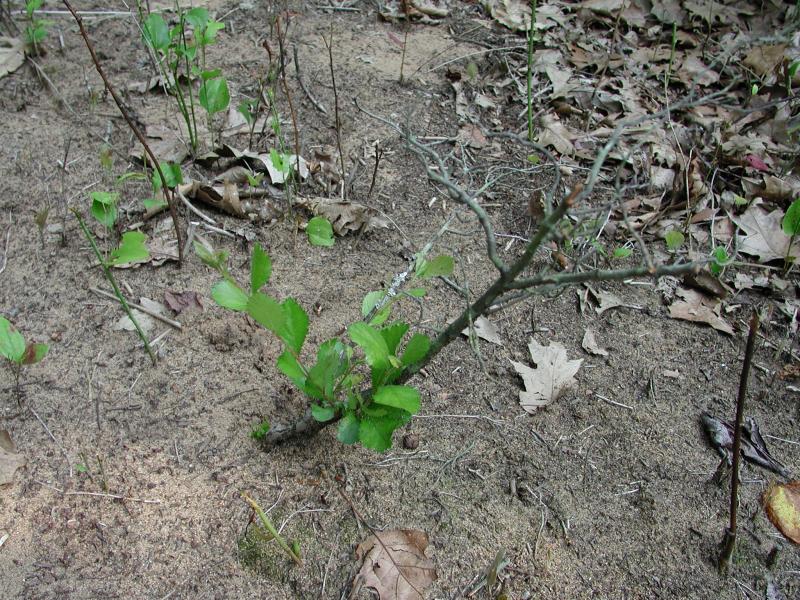Dwarf Hawthorn
Crataegus uniflora Muenchh.
- Class
- Dicotyledoneae (Dicots)
- Family
- Rosaceae (Rose Family)
- State Protection
- Endangered
Listed as Endangered by New York State: in imminent danger of extirpation in New York. For animals, taking, importation, transportation, or possession is prohibited, except under license or permit. For plants, removal or damage without the consent of the landowner is prohibited.
- Federal Protection
- Not Listed
- State Conservation Status Rank
- SH
Historical (Possibly extirpated) in New York - Missing from New York; known only from historical records (more than 30 years ago), but still some possibility of rediscovery upon further searching.
- Global Conservation Status Rank
- G5
Secure globally - Common in the world; widespread and abundant (but may be rare in some parts of its range).
Summary
Did you know?
This small hawthorn was first collected in New York in 1868 near Tottenville, Staten Island. It was only collected six more times on Long Island and Staten Island up to July 1919. It was not seen again in New York until 2003 when one small shrub was rediscovered near Kreischerville, Staten Island, a locality where it had been last collected almost 100 years earlier!
State Ranking Justification
There is one existing population in a state park but it is under stress by deer browse and may not be viable. There are six historical occurrences.
Short-term Trends
One small shrub barely continues to survive on Staten Island.
Long-term Trends
This shrub has always been very rare in New York but apparently populations have declined on Long Island since no plants have been found in recent decades.
Conservation and Management
Threats
Browsing by deer and inadvertent trampling by humans are threats to the remaining population.
Conservation Strategies and Management Practices
The remaining one shrub needs to be protected from deer and humans by erecting a protective barrier.
Research Needs
Research is needed to figure out the best way to augment the surviving population.
Habitat
Habitat
The only known, current record of Dwarf Hawthorn in New York is from a sandy opening in a Staten Island coastal forest. (New York Natural Heritage Program 2010). Open woods and dry slopes (Rhoads and Block 2000). Usually in sandy or rocky ground (Gleason and Cronquist 1991). Sandy or rocky banks and woods (Fernald 1970).
Associated Ecological Communities
- Coastal oak-beech forest
(guide)
A hardwood forest with oaks and American beech codominant that occurs in dry well-drained, loamy sand of morainal coves of the Atlantic Coastal Plain. Some occurrences are associated with maritime beech forest.
- Coastal oak-heath forest*
(guide)
A low diversity, large patch to matrix, hardwood forest that typically occurs on dry, well-drained, sandy soils of glacial outwash plains or moraines of the Atlantic Coastal Plain. The forest is usually codominated by two or more species of scarlet oak, white oak, and black oak.
- Coastal oak-hickory forest*
(guide)
A hardwood forest with oaks and hickories codominant that occurs in dry, well-drained, loamy sand of knolls, upper slopes, or south-facing slopes of glacial moraines of the Atlantic Coastal Plain.
- Coastal oak-holly forest*
(guide)
A semi-deciduous to mixed deciduous-evergreen broadleaf forest that occurs on somewhat moist and moderately well drained silt and sandy loams in low areas on morainal plateaus. In New York State this forest is best developed on the narrow peninsulas of eastern Long Island. The trees are usually not stunted, and are removed from the pruning effects of severe salt spray. The dominant canopy trees are black oak, black gum, red maple, and American beech. American holly is abundant in the subcanopy and tall shrub layers.
- Coastal oak-laurel forest*
(guide)
A large patch low diversity hardwood forest with broadleaf canopy and evergreen subcanopy that typically occurs on dry, well-drained, sandy and gravelly soils of morainal hills of the Atlantic Coastal Plain. The dominant tree is typically scarlet oak. The shrub layer is well-developed typically with a tall, often nearly continuous cover of the evergreen heath, mountain laurel.
* probable association but not confirmed.
Associated Species
- Acer rubrum
- Eupatorium hyssopifolium var. laciniatum
- Liquidambar styraciflua (sweet-gum)
- Nyssa sylvatica (black-gum, sour-gum)
- Pinus virginiana (Virginia pine)
- Quercus palustris (pin oak)
- Quercus rubra (northern red oak)
- Quercus stellata (post oak)
- Quercus velutina (black oak)
- Rhexia virginica (Virginia meadow-beauty)
- Smilax rotundifolia (common greenbrier)
- Solidago speciosa (showy goldenrod)
- Vaccinium corymbosum (highbush blueberry)
Range
New York State Distribution
It is currently known from one population on Staten Island with historical records in the Manorville/Yaphank area of Suffolk County. An 1895 specimen has also been identified from Chautauqua County.
Global Distribution
This shrub is most common in the southeastern United States from Texas and Oklahoma east to Missouri, Kentucky, Ohio, Pennsylvania, and New Jersey. Its northern limit is reached in New York where it is rare.
Identification Comments
General Description
Dwarf hawthorn is a slender shrub growing up to 2 meters tall. Its twigs have long (2 to 7.5 cm) sharp thorns, and are slender and soft-hairy when young. The leaves are alternate, toothed, and obovate to elliptic or spatulate, shiny above and hairy on the veins below. They are borne on short (2 to 5 mm) hairy petioles. The flowers have 5 white petals, and are borne singly (or rarely in clusters of 2 or 3). The 5 green, toothed sepals persist at the top of the fruit, which are greenish-yellow or red pomes (Gleason and Cronquist 1991).
Best Life Stage for Proper Identification
This shrub can be identified when it is in leaf and also in fruit.
Similar Species
Having only one (or rarely two or three) flowers per cluster distinguishes Dwarf Hawthorn from all other Crataegus species in New York. Most other Crataegus species are larger in size.
Best Time to See
Dwarf Hawthorn flowers in May before the leaves emerge, and the fruits can remain on the shrubs through September.
- Vegetative
- Flowering
- Fruiting
The time of year you would expect to find Dwarf Hawthorn vegetative, flowering, and fruiting in New York.
Dwarf Hawthorn Images
Taxonomy
Dwarf Hawthorn
Crataegus uniflora Muenchh.
- Kingdom Plantae
- Phylum Anthophyta
- Class Dicotyledoneae
(Dicots)
- Order Rosales
- Family Rosaceae (Rose Family)
- Order Rosales
- Class Dicotyledoneae
(Dicots)
- Phylum Anthophyta
Synonyms
- Crataegus parviflora Ait.
- Crataegus smithii Sarg.
- Crataegus tomentosa L.
Additional Resources
References
Fernald, M. L. 1950. Gray's manual of botany. 8th edition. Corrected printing (1970). D. Van Nostrand Company, New York. 1632 pp.
Gleason, Henry A. and A. Cronquist. 1991. Manual of Vascular Plants of Northeastern United States and Adjacent Canada. The New York Botanical Garden, Bronx, New York. 910 pp.
Holmgren, Noel. 1998. The Illustrated Companion to Gleason and Cronquist's Manual. Illustrations of the Vascular Plants of Northeastern United States and Adjacent Canada. The New York Botanical Garden, Bronx, New York.
Little, E.L., Jr. 1979. Checklist of United States trees (native and naturalized). Agriculture Handbook No. 541. U.S. Forest Service, Washington, D.C. 375 pp.
Mitchell, Richard S. 1986. A checklist of New York State plants. Bulletin No. 458. New York State Museum. 272 pp.
Mitchell, Richard S. and Gordon C. Tucker. 1997. Revised Checklist of New York State Plants. Contributions to a Flora of New York State. Checklist IV. Bulletin No. 490. New York State Museum. Albany, NY. 400 pp.
New York Natural Heritage Program. 2010. Biotics database. New York Natural Heritage Program. New York State Department of Environmental Conservation. Albany, NY.
New York Natural Heritage Program. 2024. New York Natural Heritage Program Databases. Albany, NY.
Weldy, T. and D. Werier. 2010. New York flora atlas. [S.M. Landry, K.N. Campbell, and L.D. Mabe (original application development), Florida Center for Community Design and Research http://www.fccdr.usf.edu/. University of South Florida http://www.usf.edu/]. New York Flora Association http://newyork.plantatlas.usf.edu/, Albany, New York
Links
About This Guide
This guide was authored by: Stephen M. Young
Information for this guide was last updated on: September 6, 2012
Please cite this page as:
New York Natural Heritage Program. 2024.
Online Conservation Guide for
Crataegus uniflora.
Available from: https://guides.nynhp.org/dwarf-hawthorn/.
Accessed July 27, 2024.


